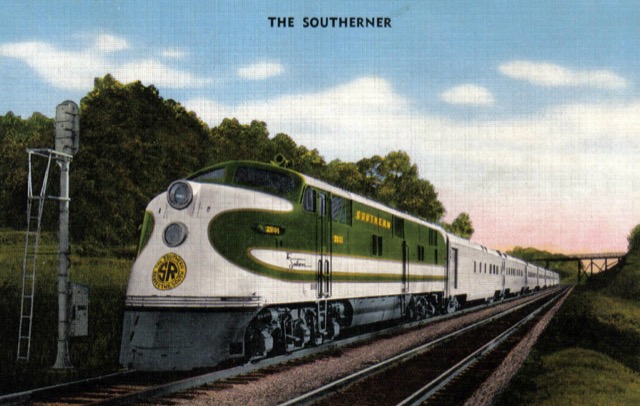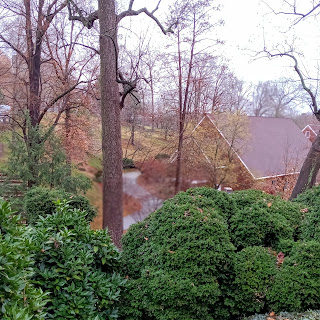child's journey
(This post was requested by my good wife.)
1943
I was 16. I graduated in Jan of 43. I had
seen an airview of the Duke campus at 10
and resolved to go there for higher education.
My folks put me on the Southerner, the main
line train that ran from New Orleans to
Boston (and maybe points farther north).
I had a seat in a coach car. I was there
23 hours, then I emerged at Greensboro, and
took the milk train which took another four
hours to get to Durham.
What an impression it made. Wow. But it was
nothing like New Orleans.
Since Larry was taking the Southerner he would have left from this station on Canal Street near Rampart. He lived at St. Mark's Methodist Church and Community Center located at 1130 N Rampart where his father had become pastor the previous year.
 |
New Orleans Terminal, Southern RR Canal Street and Basin. c 1908 |
"Bird's-eye View of New Orleans, Louisiana". Early 20th century postcard view. Text on back of card: "Bird's-Eye View Of New Orleans LA. This view is taken from the top of Hotel Grunewald showing that section of the City lying beyond the New Orleans Terminal Passenger Station". View shows a section of Canal Street at bottom left. Rampart street is to bottom of photo (someone has labeled it in green ink pen). The building with the large arch fronting Canal Street is the old Basin Street railway terminal. Krauss store visible on Canal just beyond it. Of particular interest is the row of buildings seen fronting Basin Street, including Tom Anderson's, Josie Arlington's, and Lulu White's, and "the District" behind it. This is one of the few published cards showing what history recalls as "Storyville"; from the card's language about "that section of the City" this was clearly an intended focus. The line of the old Carondelet Canal is slightly visible diagonally towards the top of the view. Note the view of the buildings at Canal and Rampart Street which were demolished for the construction of the new Saenger Theater in the 1920s."
 |
| St Mark's Methodist Church and Community Center |
"In 1909, the work of the Mary Werlein Mission moved to Esplanade Ave. and was called St. Marks Hall. Out of this project, a "Church of Nations" emerged and was called St. Marks Methodist Church. The property on N. Rampart was purchased in 1916 and the buildings dedicated in 1924. The church and community center, though separate, shared the facilities. The church was supported for many years by the Board of Missions. Under Rev. Robert Jamieson, he church became self-supporting in 1946. Rev. Jamieson's 'parsonage' was a 5 room apartment on the 3rd floor of the community center."
"By
this time we were living at St. Mark's Community Center on North
Rampart St. on the edge of the French Quarter. It was still in the
Nichols School District. I rode the Rampart St. streetcar every morning
down St. Claude Ave. to school and back in the afternoon. We lived on
the third floor of the community center directly above the swimming
pool. There was also a gymnasium. On the other wing was the church,
which Daddy served. A fairly small church it still had representatives
of 21 nationalities. I suppose it was pretty close to unique in the
denomination. Dad got along pretty well there, stayed four years, the
first time he had ever had an appointment that long. He liked New
Orleans and had no desire to leave. In fact all the ministers liked New
Orleans. Those who got there stayed as long as they could."
"In 1942 I bought a used bicycle on time (50 cents/week) and went to work as a Western Union messenger (people communicated by telegram in those days). The job was roughly from 4 to midnight, although sometimes I worked longer.
It must have been after Christmas that I found employment
as a Western Union delivery boy. For the next few months I rode my bike
all over the city. I remember going as far as Westwego--a long, long
way from 314 Carondelet, the Western Union Office. I frequently rode
as much as 30 miles. The original idea was to work a few hours in the
afternoon, but like so many of those low level jobs, they were always
short of help, and I worked as long as I wanted to.
I rode all over Orleans Parish that year, and
parts of Jefferson and St. Bernard delivering telegrams in dozens of
"houses of ill fame"; those girls were anxious to hear from someone.
(It was said that every brothel in N.O. was on property owned by the
mayor; he was also reputed to be allied with the New York mafia. N.O.
was a rocky city in those days, as it has always been.)"
The big thing in my world was to get on the Southerner a few days later and make the 23 hour ride to Durham where I enrolled at Duke. This represented a desire to get away from home, especially to get away from my father, toward whom I had harbored very negative feelings for a number of years. I got away, and I never came back (to live), although I certainly did visit from time to time."
Dylan's version of House of the Rising Sun
There is a house down in New Orleans they call the rising sun
And it's been the ruin of many a poor girl and me, oh God, I'm one.
My mother was a tailor, she sowed these new blue jeans
My sweetheart was a gambler, Lord, down in New Orleans.
Now the only thing a gambler needs is a suitcase and a trunk
And the only time when he's satisfied is when he's on a drunk.
He fills his glasses up to the brim and he'll pass the cards around
And the only pleasure he gets out of life is rambling from town to town
Oh tell my baby sister not to do what I have done
But shun that house in New Orleans they call the rising sun.
Well with one foot on the platform and the other foot on the train
I'm going back to New Orleans to wear that ball and chain.
I'm going back to New Orleans, my race is almost run
I'm going back to end my life down in the rising sun.
There is a house in New Orleans they call the rising sun
And it's been the ruin of many a poor girl and me, oh God, I'm one.
________________________
Another sad tale connected to this account is the attempted integration of the New Orleans Public School system in 1960. In the vicinity of St Marks United Methodist Church were the two schools which had been selected to have a few black first graders enroll in white schools. The whites protested with demonstrations and refusal to send their children to the schools with the little black girls. When the minister at St Mark's Rev Lloyd Anderson Foreman saw the reaction he broke the boycott by walking his 5-year-old daughter Pam through an angry mob back to school.










